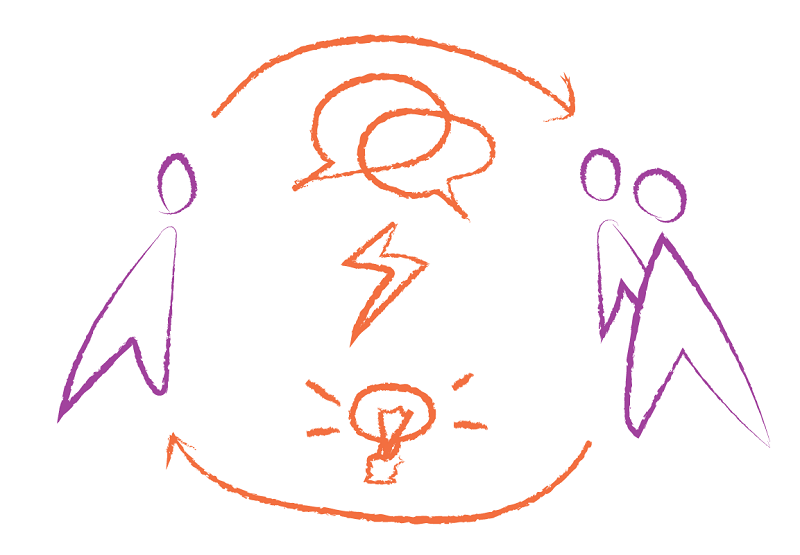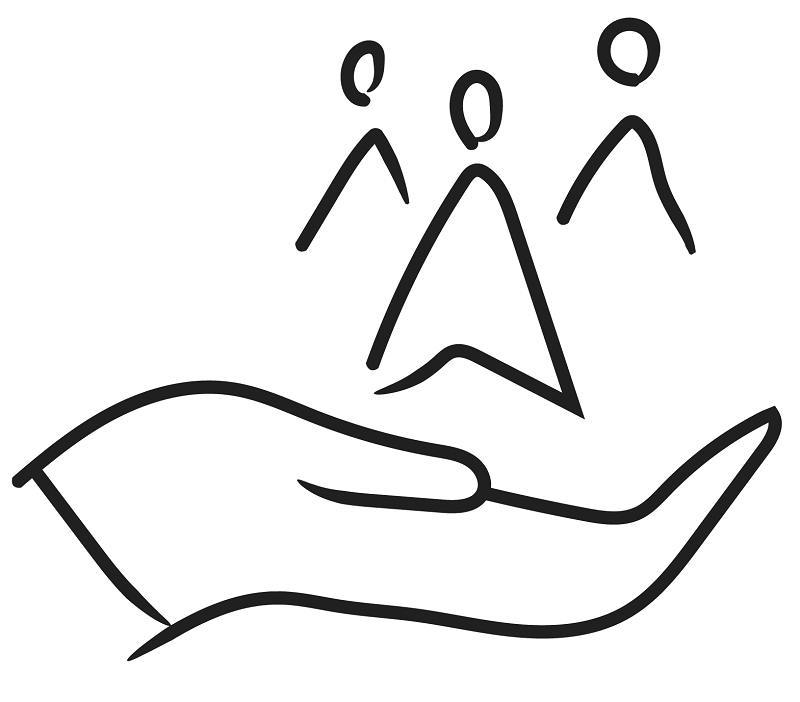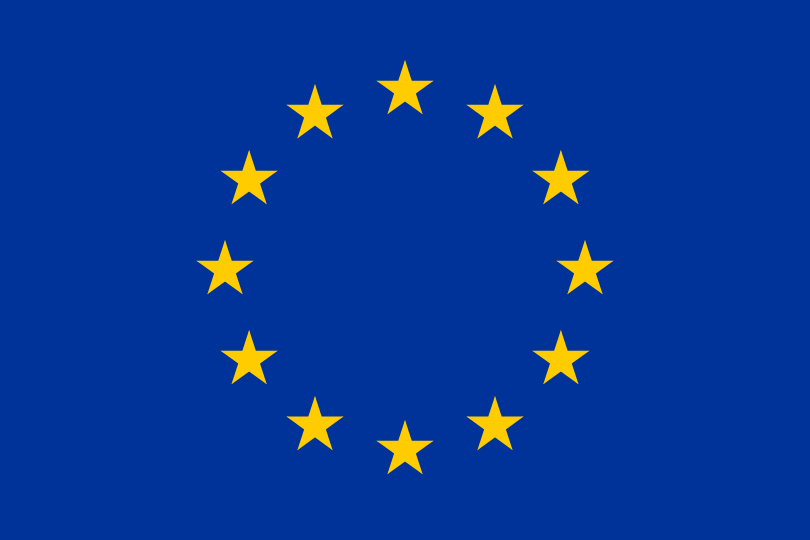SIEs change social relations and involve new ways of doing, thinking and organising energy:
- by doing we mean practices related to energy technologies and the physical composition of the energy system, such as producing, supplying or storing energy or heat, installing energy technology or taking action against political agendas;
- new ways of thinking are such forms of knowledge and framings including values and perceptions as “raising awareness” about energy, campaigning against political agendas or transferring knowledge and skills
- organising refers to governance and organisational structures within initiatives and within the energy system, for example constructing a dialogue, incubating ideas and solutions or facilitating change of behaviour.
Social relations are described here through different types of social interactions between actors – cooperation, exchange, competition, conflict:
- cooperation means working together to achieve shared goals. Teamwork is more likely to occur when individuals are faced with a common threat, when it serves their economic self-interest, when they share a sense of community identity, or when they value belonging to a community;
- exchange is voluntary interaction from which everyone wants to benefit. Such relationships are based on the norm of reciprocity – if you give something, you expect a reward;
- competition refers to interaction based on competition over scarce resources which is regulated by shared rules;
- conflict – unlike competition, interaction based on conflict over scarce resources is not regulated by shared rules.
Local energy production and consumption
(Cooperation/Doing)
Local partners may come together to sustain the community with green electricity or heat. They jointly invest in renewable energy installations, such as photovoltaic panels or wind turbines, to produce and deliver electricity locally. Such partnerships are usually led by actors from the public sector (e.g. municipality, regional authority, national government) and non-profit sector (e.g. NGOs, community, energy organizations).
Examples:
Back to table.
Cooperative energy production and consumption
(Cooperation/Doing)
Green electricity or heat can also be produced and delivered by the local community in a cooperative model.
There is an increasing number of cooperative business models that are initiated and run by community-led energy organisations, such as energy cooperatives or community benefit societies. Their goal is to provide renewable energy locally.
Examples:
- Sandford Hydro: Cooperative management of community energy (United Kingdom)
- NDSM energie: Cooperative management of community energy for businesses (The Netherlands)
- 123 soleil: Cooperative management of community energy (France)
Back to table.
Collaborative eco-efficient housing
(Cooperation/Doing)
More and more municipalities, communities, housing associations or developers are investing in building energy-efficient housing complexes and eco-efficient neighbourhoods. Some of them even generate their own electricity using green energy installations, such as solar panels. The purpose? Energy savings within housing and more efficient energy consumption in communities. Such projects are formally managed by housing organisations.
Examples:
Back to table.
Local peer-to-peer electricity exchange
(Exchange/Doing)
The initiatives grouped in this cluster are focused on exchanging energy. In some neighbourhoods and communities it is possible to exchange electricity locally – between households – using tools like bitcoin or smart technology. Usually this kind of project involves many partners, spanning the community, energy distribution system operators (DSO), municipality, energy utility, etc. As local energy distribution is not institutionalised, many peer-to-peer electricity exchange projects are led as experiments and take the form of city labs or living labs.
Examples:
- Jouliette: Local electricity exchange through locally organized electricity grid (The Netherlands)
- West Sussex County Council BISEPS project: Electricity exchange through a locally-organised electricity grid, done via a city lab (United Kingdom)
- Living Lab Walldorf: Electricity exchange through a locally-organised electricity grid, done via a city lab (Germany)
Back to table.
For-profit services and technologies
(Competition/Doing)
Companies and start-ups also contribute to social innovation in energy transitions. They initiate and manage novel competitive services and profit-oriented business models focused on green energy production and supply. From installing renewable energy technologies and providing technology-based services, to delivering automation software and smart solutions to optimise energy use – companies and start-ups provide plenty of novel services aimed at greater energy efficiency.
Examples:
- EnergyFlex: For-profit renewable energy utility with flexible, pre-paid contracts (The Netherlands)
- Restore: For-profit demand-response-management service to lessen energy costs (Belgium)
- Change!Energy: For-profit renewable energy utility with transparency and a guarantee of energy origin (Germany)
Back to table.
Action against specific energy pathways
(Conflict/Doing)
We cannot have an energy transition without changing mainstream energy practices. One way to create change – protest and campaign. Physical action, such as blocking or barricading coal plants or protesting against fossil fuels or nuclear energy, can have direct implications for energy production and supply. Social movements, informal groups and grassroots organisations are the most active actors in this cluster.
Examples:
Back to table.
Advocacy for specific energy pathways
(Cooperation/Thinking)
Another type of social innovation for energy transitions is collective campaigning and advocacy for alternative energy practices, and lobbying for a political agenda, for example, against fuel poverty. This kind of activity is usually driven by communities or multi-actor constellations and coalitions engaged in promoting topics like efficient energy use, energy poverty, or diversity and gender issues.
Examples:
- Community Energy Coalition: Coalition of community energy initiatives that lobby for government support (United Kingdom)
- Vrouwen in Energie Noord Nederland (VIEN): Social network lobbying for diversity and inclusion in energy (The Netherlands)
- Allianz Atomausstieg: Campaign for nuclear phase-out (Switzerland)
Back to table.
Energy education
(Exchange/Thinking)
How do you raise awareness on energy efficiency? How can we teach people about alternative energy sources? The main goal of initiatives grouped in this cluster is to educate and train others on diverse topics around sustainable energy. This work is not-for-profit and usually takes the form of workshops, trainings, educational programmes, fora, online platforms, or toolkits, and often includes a social goal, like increasing inclusivity or decreasing energy poverty. These efforts can be initiated by various actors, such as municipalities or networks, and are aimed at educating diverse groups spanning citizens, students, minority groups, prosumers and many others.
Examples:
Back to table.
Non-profit consulting
(Exchange/Thinking)
Would you like to find out how to better save energy in your house? Or perhaps you have considered installing solar panels on your roof, but you are not sure where to start? More and more NGOs, community-led organisations and municipalities are offering advisory services for free. Their support is usually directed at households and communities who want to inform themselves on how to better save energy in their homes.
Examples:
- Noé21: Non-profit consultancy on energy transition led by civil-society (Switzerland)
- Community Energy Scotland: Non-profit advisory, providing support for and knowledge on community energy (United Kingdom)
- Centrales villageoises: Association-led advisory on community energy (France)
Back to table.
Peer-to-peer learning
(Exchange/Thinking)
We don’t always need to rely on experts when we want to learn more about sustainable energy – peer-to-peer learning can also be highly effective. There are many ways to meet up with people engaged in energy transition processes to exchange knowledge and experiences. These range from workshops, trainings, education programmes, fora or toolkits to informal carbon conversations, meetings with energy coaches, or discussions on online platforms. The topics covered usually include energy savings, emissions reduction, or renewable energy. This kind of knowledge transfer can be initiated by various actors, such as companies, governments, NGOs or communities.
Examples:
- Conversations carbone: Facilitated conversations for peer-to-peer learning on reducing emissions (Switzerland)
- Samen-Sneller-Duurzaam: Network for peer-to-peer learning to accelerate energy transitions (The Netherlands)
- Forum Synergiewende: Online forum for peer-to-peer learning to accelerate energy transitions (Germany)
Back to table.
For-profit consulting
(Competition/Thinking)
Among the various actors co-creating social innovation for energy transitions there are also experts, who offer their consultancy for sustainable energy. These are paid services that take the forms of legal support, energy savings advice, or smart grid advising, provided by for-profit consultancies or think-tanks.
Examples:
- Instytut Energetyki Odnawialnej (IEO) : Expert advisory on renewable energy through think-tank (#427 , Poland)
- Lux Nova Partners: Expert advisory service on legal topics of renewable energy (#26 , United Kingdom)
- energie experten: Expert advisory on energy savings through civil-society experts (#464 , Germany)
Back to table.
Campaigns against specific energy pathways
(Conflict/Thinking)
Physical action is not the only way to protest against mainstream energy practices. This cluster features examples of peaceful opposition and campaigns against current energy pathways, as well as lobbying initiatives that advocate for political agendas. This type of action is usually driven by multi-stakeholder collaborations, associations, NGOs and grassroots organisations.
Examples:
Back to table.
Participatory energy dialogues
(Cooperation/Organising)
Finding and creating a shared understanding of green energy requires social innovation. New ways of organising spaces to facilitate dialogue and deliberation on various energy-related topics – including energy savings, electricity grids and urban climate policies – often engages citizens in co-creation of urban policies. This type of action is mostly initiated by community-led or grassroots organisations and by public actors, such as municipalities.
Examples:
- Warszawski Panel Klimatyczny: Representative citizen panel for deliberating urban climate policy (Poland)
- Bürgerdialog Stromnetz: Dialogue involving citizens on expansions of the electricity grid (Germany)
- Convention citoyenne pour le climat: Randomly-selected citizen assembly for discussing greenhouse gas emissions reductions (France)
Back to table.
Participatory experimentation and incubation
(Cooperation/Organising)
While participatory dialogue methods can be used to discuss and debates paths forward, participatory incubation uses facilitated spaces to spark the development of ideas, projects, solutions, technologies, programmes, services, and more. Their goal is to test and showcase experiments for sustainable energy – including both technical and social solutions – and to accelerate innovation. Such actions are driven by multi-actors constellations.
Examples:
Back to table.
Platforms for direct energy transactions
(Exchange/Organising)
Energy transactions – such as peer-to-peer exchange of electricity or biogas – can be facilitated through software or online marketplaces, such as platforms that match suppliers to customers. These often make use of smart technology and bitcoin.
Examples:
- Vandebron: Online marketplace to connect consumers and producers of renewable energy (The Netherlands)
- Powerpeers: Online marketplace to connect consumers and producers of renewable energy (The Netherlands)
- ILEK: Online marketplace to connect hydropower/biogas suppliers with households (France)
Back to table.
Investment and finance mechanisms
(Exchange/Organising)
Various schemes exist for accessing money from public or community investments in support of renewable energy generation or energy efficiency measures. These schemes include national subsidies, municipal funds, and much more.
Examples:
- Bristol community energy fund: Municipal fund for community energy initiatives (United Kingdom)
- Mannheim begrünen: Municipally-supported company fund for roof and facade greening (Germany)
Back to table.
Energy gamification and nudges
(Competition/Organising)
Competition help us change our energy practices – after all, who wouldn’t want to become a champion of energy savings, or an inhabitant of the most energy-efficient building? Such challenges in the form of games, apps and competitions, or that present as awards and certificates, are usually organised by municipalities or non-profit organisations to “nudge” people to adopt more sustainable behaviour. Sometimes winner are rewarded simply with smugness and a sense pride for becoming a role model for others, while other games provide in-kind financial rewards. So keep your eyes on the prize!
Examples:
- jeu de l’oie sur les énergies: Board game that playfully facilitates energy savings (France)
- Energiestadt Label: Label awarded to municipalities who exhibit above-average efforts in their sustainable energy policies (Switzerland)
- Déclics: A programme that provides playful nudges towards energy saving behaviour (France)
Back to table.
Networks against specific energy pathways
(Conflict/Organising)
A single organisation that advocates for an alternative energy pathway can make a difference. However, organisations will often also come together as coalitions and networks to make their voices even louder. This kind of collective action is usually driven by multi-stakeholder collaborations, associations, NGOs and grassroots organisations, and uses methods like peaceful opposition, lobbying, and campaigns to advocate against mainstream energy practices.
Examples:
- Zielona Transformacja Śląska: Coalition of associations facilitating collaborative opposition of open-cast mining (Poland)
- Freie Landschaft Schweiz: Online platform facilitating dialogue on the effects of wind turbines on landscape quality (Switzerland)
Back to table.







 The project has received funding from the European Union’s Horizon 2020 research and innovation programme under grant agreement No 837498.
The project has received funding from the European Union’s Horizon 2020 research and innovation programme under grant agreement No 837498.